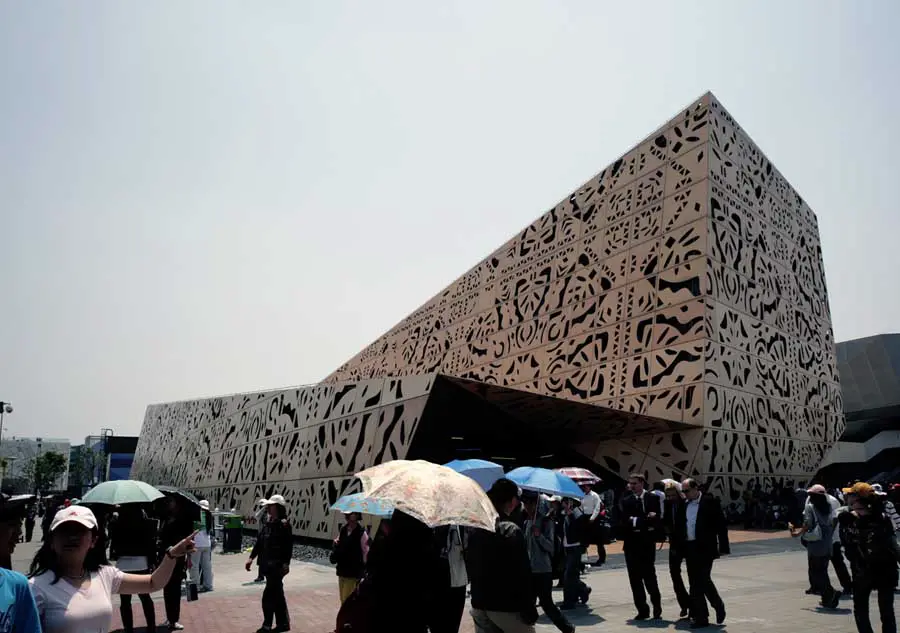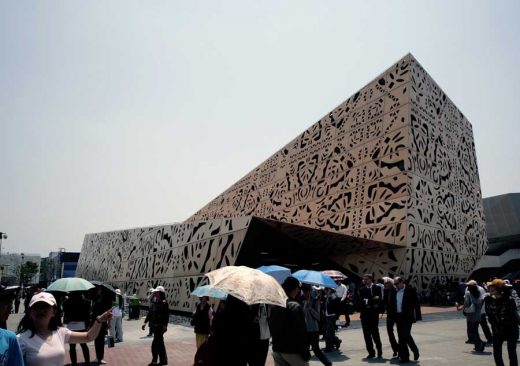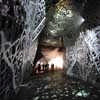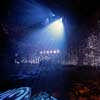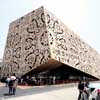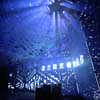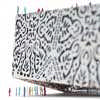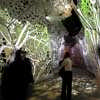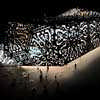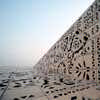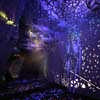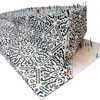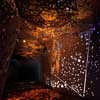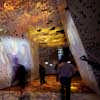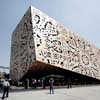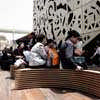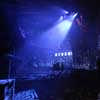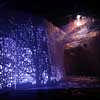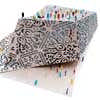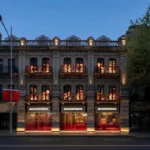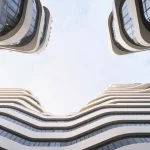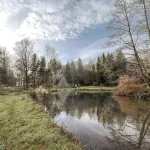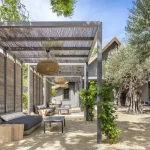Shanghai Expo 2010 Polish Pavilion, Images, WWAA Architects, Chinese Design
Shanghai Expo Polish Pavilion
Architecture Information China – design by WWAA Architects
17 May 2010
Polish Pavilion at Shanghai Expo 2010
Design: WWAA Architects
THE PROJECT CONCEPT
In the contemporary world with its abundance of visual experience, with the pictorial language of communication reigning supreme, with the almost unconstrained and instant accessibility of iconographic material, an exposition piece of architecture will only be attractive insofar it can offer perceptual sensations attainable only through direct, unmediated exposure to out-of-the-ordinary, singular stimuli, insofar it can provide a quality of experience born out of the chemistry of inter-sensory stimulation.
Given the nature of the exposition, the exhibition facility has to denote, by its esthetic distinctiveness, the country of origin, has to constitute, by the strength of its stylistic connotations, an evocative, recognizable and memorable cultural ideogram. In our design, the cultural idiom is primarily conveyed through the theme, the motif of folk-art paper cut-out. Or, more precisely, through a rendering of the motif, a transcription of an elementary esthetic code into the contemporary language of architectural decor.
The transcription rationale was twofold. First of all, we did not wish the design to be literally folklorish, a mechanical multiplication of convention-approved set patterns. The intention was for the structure decor to draw on and make reference to tradition, but ultimately to be that tradition’s contemporary reinterpretation, a creative extension into the present day by way of inspiration rather than replication. Secondly, we aspired to make the structure in its own right, in a purely architectural dimension, a significant landmark, a showcase of Polish design achievements.
That it should be an attractive, eye-catching exterior both in daylight, against the panorama of other Expo facilities, as well as a mesmerizing experience at night with the edifice drawn by the multi-colored light seeping through the cut-out patterns. And reversely, that it should provide inside visitors with comparable experience by shaping the outer skin patterning in such a way that the sun rays shining through would chisel, by light and shade, the space under the vault.
The structure’s overall shape, with many slanting planes, on the one hand complements and rounds out, by the suggestion of a folded sheet of paper, the ‘cut-out’ narrative, on the other creates inside a geometrically intriguing and flexible space that can be creatively apportioned, by inner divisions, to different exhibition, performance and utility functions and uses.
FUNCTIONAL ARRANGEMENTS AND EXHIBITION DESIGN
The outside structure of the pavilion and its reflection in the proposed arrangement of its inside functions impose on the visitors taking and following a route which is consistent with the logic of the building. The entrance way – an interlude between an inside and outside body of the construction, is accessible from the square marked out between the pavilions. The partial roof created by the fold in the building, allows for providing a shelter for the queues of visitors. Next the visitors proceed to the main, full-height exhibition area of the pavilion. Auxiliary functions, a shop and a restaurant have been designed in the lowest part of the building while the higher part of the pavilion hosts the main exhibition area.
The interior design is a continuation of the architectural idea of the form of the building and the details of the facade. The aesthetic concept of the pavilion is brought inside and the folk cut-outs lead the visitors through the entrance into the main hall and then, while transforming into other patterns, are continuously guiding them along all the exhibition. The usage of the cutout patterns has not only an aesthetic value, but also an educational function associated with the main theme of the EXPO: „better cities-better life”. The cut-outs changing from the folk forms into organic ones and finally into a city-map and industrial patterns are a metaphor of migration of people from countryside into cities.
The story that the patterns are suppose to tell is the base for the presented images and films showing Poland through its history, culture, economy and every-day life. The design of the cut-outs goes with the presented on it contents changing along the visitors’ route.
MATERIAL SOLUTIONS
The outer layer of the elevation, with its characteristic design inspired by a traditional folk-art paper cut-out, is made of impregnated CNC plotter-cut plywood mounted on steel construction modules with steel substructure. Panel wall elements PC are mounted on the outer side of the modules. Both the exterior, entrance way surface and the interior of the pavilion will be covered with impregnated wooden flooring.
The choice of materials and the character of construction were to a large extent dictated by the idea of possible future reclaiming and recycling of the pavilion structure or its parts, e.g. by reconstructing it in one of the Polish cities after the closing of EXPO.
The colorist effects were determined by the choice of plywood panels in natural wood color. When the dusk falls the elevation will acquire different colors according to the changes of light penetrating the cut-out patterns.
LANDSCAPING
The entrance yard constitutes the integral part of the ground floor of the pavilion. The pattern of the exterior flooring divisions as well as the material used are continued inside the building. The form of outdoor and indoor furniture has been inspired by the elevation patterns. There is a concept of using the elements cut out from the elevation plywood for producing the furniture, in the form and material which will directly refer to the pavilion architecture.
TEAM:
Architects Marcin Mostafa and Natalia Paszkowska are founding partners of WWAA. They co-operated as students of Warsaw Technical University on school projects and have been working together since 2003, with focus on projects for architectural contests, of which majority they won or were awarded prizes. WWAA undertakes actions in many scales ranging from graphics, every-day use objects to furniture, urban objects, interiors, houses, office buildings as well as public buildings.
Marcin Mostafa. Born in 1979 in Warsaw. MSc Diploma in Architecture from Warsaw University of Technology. In 2003 obtained the first prize in the student competition. In 2005 awarded the first prize and the execution of the project of a small pavilion in the competition organized in Warsaw. In 2007 a distinction in the prestigious competition for a design of an office building to be erected in the centre of Warsaw in place of a demolished Supersam pavilion (in team with G, Stiasny and J. Wacławek – ARE architectural office). Also involved in designing stage scenery for the theaters in Warsaw, Lodz and Radom, theatrical posters and clothes collections.
Natalia Paszkowska. Born in 1981 in Katowice. MSc Diploma in Architecture from Warsaw University of Technology. Since 2004 has been acquiring professional experience in such Poland’s leading architectural offices as Jems Architects, Group 5, APA Kuryłowicz. In 2005, together with Marcin Mostafa, awarded the first prize and the execution of the project of a small pavilion in the competition organized in Warsaw.
Marcin Mostafa and Natalia Paszkowska have been cooperating as WWAA since 2005. They have entered for the EXPO 2010 competition together with their friend Wojtek Kakowski. In 2008 they won together with Jan Sukiennik competition for cultural centre in Warsaw (construction 2010). In 2009 together with Boris Kudlicka they have designed the exhibition inside Polish Pavilion.
Boris Kudlička. Born in 1972 in Ružomberok. A graduate of the Academy of Music in Bratislava 1996. He works regularly with several stage directors. Since 1999 Boris Kudlička has produced 12 operas with Mariusz Treliński: Madame Butterfly,
King Roger, Otello, Don Giovanni, Eugene Onegin, The Queen of Spades, Andrea Chenier, La Boheme, Orfeo ed Euridice, Boris Godunov, Iolanta, Aleko, Traviata – mainly for the Polish National Opera in Warsaw, but also for other opera houses (including in Berlin, Moscow, St. Petersburg, Washington, Los Angeles, Tel Aviv, Bratislava, and Valencia). The operas were also presented at several opera festivals, including the Edinburgh International Festival, the Hong Kong Festival, and the Tokyo Festival.
With Dale Duesing, he staged Rossini’s Il Viaggio a Reims and Britten’s The Rape of Lucrezia for the Frankfurt opera house, Medea for the Enschede opera, Hansel and Gretel for the opera house in Bern and Chabrier`s L`Etoile for The Staatsoper Berlin. Death in Venice marked the start of his collaboration with Keith Warner, and was followed by Aribert Reimann’s Lear and Thomas Ades’ The Tempest for the Frankfurt opera house, and Verdi’s Simon Boccanegra for the Strasbourg opera.
In 1997 he won the gold medal at the Prague Quadrennial 2007, and in 2008 was appointed general commissioner of the Prague Quadrennial 2011. Presently, he is working on productions for the opera houses of Berlin, Frankfurt, Toronto, Strasbourg, Tel Aviv, Warsaw, and Łodź. Together with WWA Architects he designed the Polish pavilion for Expo 2010 in Shanghai.
W W A A Pracownia Projektowa
PROJECT: POLISH PAVILION FOR EXPO 2010, SHANGHAI
DESIGNED BY: WWAA, Marcin Mostafa, Natalia Paszkowska
CLIENT: Polish Agency for Enterprise Development
COLLABORATION: Wojciech Kakowski
AREA: 2400 sqm
YEAR: design 2007 (competition first prize), construction 2010
BUDGET: ca 11 000 000 PLN
PROJECT: EXHIBITION IN POLISH PAVILION FOR EXPO 2010, SHANGHAI
DESIGNED BY: WWAA, Boris Kudlicka, Marcin Mostafa, Natalia Paszkowska
CLIENT: Polish Agency for Enterprise Development
AREA: ca 1500 sqm
YEAR: design 2009, construction 2010
BUDGET: ca 9 000 000 PLN
Shanghai Expo Polish Pavilion images / information from WWAA Architects
Location: Shanghai, China
Shanghai Architecture
Shanghai Architecture Designs – chronological list
Shanghai Building – Expo Pavilion Selection
Shanghai Expo 2010 Danish Pavilion
Shanghai Expo British Pavilion
Shanghai Expo 2010 Spanish Pavilion
Shanghai Expo 2010 Building by BIG
Comments / photos for the Shanghai Expo Polish Pavilion 2010 Architecture page welcome

